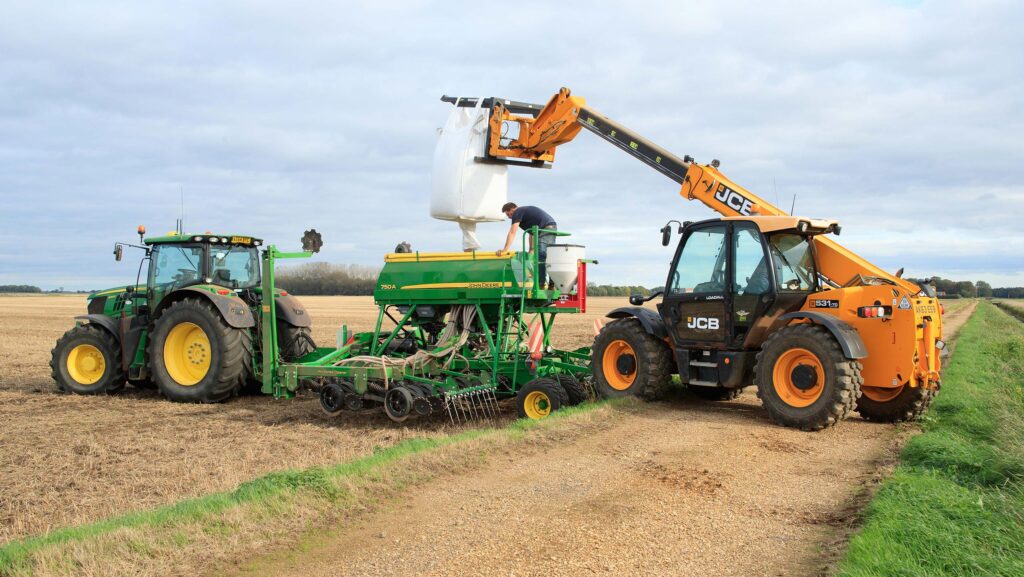Cereals 2024: After 80 years, where next for Recommended List?
 © MAG/Richard Allison
© MAG/Richard Allison The future direction of the AHDB’s Recommended List (RL) and the need for it to reflect the move to more sustainable farming systems was the focus at Cereals 2024, as the list reached its 80th anniversary milestone.
While its remit remains the same – helping farmers and supply chain partners to select the best varieties – there is recognition of the different pressures on farm businesses today and the need to keep the list relevant.
See also: Cereals 2024: Advice on wheat actives to counter brown rust
As AHDB chief executive Graham Wilkinson points out, the RL has been widely used and highly valued for the past 80 years, so standing still is not an option.
“It’s close to a £25m investment when you add in all the funding contributions that it attracts,” he says. “From its earliest days in 1944, when the post-war focus was all about output, to today’s need for varieties that help to reduce risk, it has to keep evolving.”
Some changes have already been implemented following last year’s review of the RL, which received about 900 responses, and others are ongoing, RL manager Paul Gosling confirms.
“We have revised the layout of the list, improved the online delivery and given pests and diseases greater scrutiny,” he says.
Lower input regimes
The review also put the spotlight on sustainability, with nitrogen use efficiency and fungicide programmes being selected for further focus as growers look for varieties suited to lower input regimes.
Now and then
- In 1944, the first Recommended List was limited to 16 winter wheat varieties: four for milling, seven for biscuits and five others. At that time, yields were around 1.5t/ha, says Professor Peter Gregory, chair of the RL board.
- Today’s RL has 34 winter wheats in five different market sectors, with Group 1 and Group 2 covering bread-making varieties, Group 3 being the biscuit varieties, and Group 4 feed wheats being divided into soft milling and hard milling types.
- Average winter wheat yields are 8.6t/ha but 11t/ha is regularly achieved.
- The list has also been extended to cover 11 crops.
“We’ve just published our findings on both of these,” says Paul. “In terms of nitrogen use efficiency in modern cereal and oilseed rape varieties, there’s little evidence that wheat and barley varieties differ.
“That’s not the same with oilseed rape, where there do seem to be differences between varieties.”
There is, however, some indication from Europe that wheat varieties bred for low-input regimes can maintain yields at low nitrogen rates, so some reduced-nitrogen trials at RL sites are being considered.

© Tim Scrivener
Fungicide programmes on winter wheat have also been scrutinised – with researchers concluding that variety responses to reduced fungicide inputs could be predicted from treated and untreated yield data and disease resistance ratings.
“It wouldn’t be possible to replicate all the fungicide programmes used by farmers, and we need to consider the best use of resources,” notes Paul. “It could easily add £500,000 to the five-year project budget.”
What about cultivations?
Cultivation method is another variable which may affect variety performance, say growers, who are keen to see some work done in this area.
With one of the latest SFI actions encouraging a move to no-till, pressure from levy payers will remain on the AHDB to use its resources to reflect on-farm practice.
The farmer’s view
For Cambridgeshire grower Russell McKenzie, the Recommended List is a valuable resource which tells him a great deal about the risk he is exposing his business to as the climate changes.
“This year is a really good example,” he says. “Disease pressure has been huge, so variety choice and the ability to withstand attack has been more important than ever.”
He admits to glancing at the yield figures of varieties, but pays more attention to the disease profiles. A septoria rating of above 6 is his target, with minimum rust ratings being tricky to pinpoint.
“Rust doesn’t obey the rules, as we’re seeing this year with varieties like Crusoe,” he says.
In practice, he uses the untreated yield data to tell him how far a variety might fall. “We need consistent, reliable performance from varieties and we also need the RL to give us enough warning of when to make changes,” he says.
The breeder’s view
Richard Summers, head of cereal breeding and research at RAGT, confirms that security of production and disease resistance are on every breeder’s agenda, with companies working five to six years ahead to bring improvements to market.
Emphasising that there had been no reduction in effort in breeding varieties for the UK, he highlights that the main benefit of the RL is that it lets farmers compare varieties and make specific choices for their needs.
“Whatever direction it takes from here, it’s wrong for the industry to expect the RL to answer all of its questions,” he says. “Don’t forget that there are other resources out there that can be useful.”
He stresses that a 0.5-1% annual yield gain is possible and that there is enough variability in breeding programmes to deliver on other characteristics too.
“There are five sources of septoria resistance in some of our advanced lines, for example,” he says. “The tools at our disposal have changed and we now have opportunities that just didn’t exist 80 years ago.”
The end-user’s view
Nicholas Pitts, supply chain sustainability manager at the Scotch Whisky Research Institute, admits that the supply chain is aware of the volatility faced by the farming industry and, like other supply chain partners, has concerns about the future security of supply.
“Our consumers want a sustainable product, so it’s encouraging that this is the direction of travel with the RL as new varieties are tested and screened,” he says.
From his point of view, the list has a good track record in delivering improved yield and malting quality.
“We want to process the best of the best,” he says. “Critics might say that we want everything – yield in the field and in the distillery – but we do understand that resilience and consistency are important for growers.”
The regulator’s view
Michael Brown, head of plant variety and seeds at the Animal and Plant Health Agency (Apha), points out that there are legal requirements which must be complied with before varieties can be accepted into the RL testing system.
“There are two tests that have to be undertaken, known as DUS and VCU,” he explains. “The first ensures that the variety is distinct from others, while the second assesses its agricultural value.
“The aim of these is to give both the consumer and the industry protection, as well as to safeguard public health.”
Otherwise, Apha’s role is to support government policy, so future direction will become clearer after the general election, he adds.
“Once varieties are in the RL system, greater detail on their performance becomes available and their potential in both good and bad years can be better understood.”

